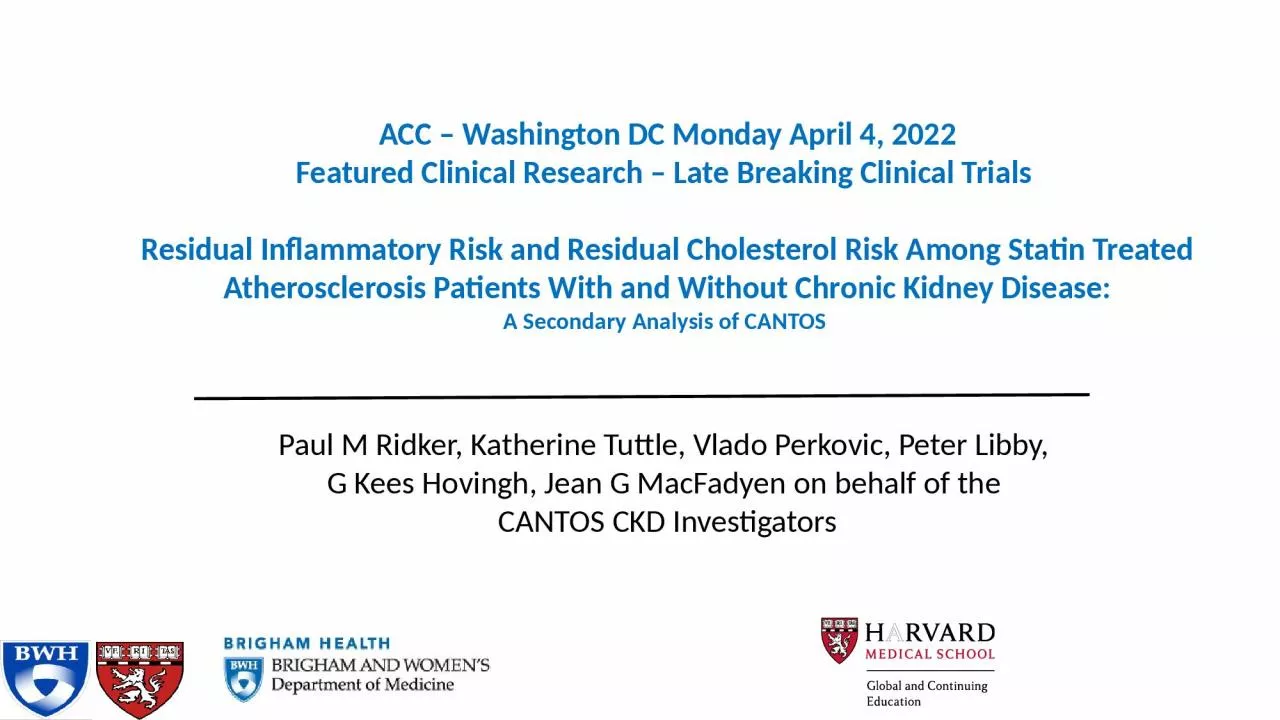

Featured Clinical Research Late Breaking Clinical Trials Residual Inflammatory Risk and Residual Cholesterol Risk Among Statin Treated Atherosclerosis Patients With and Without Chronic Kidney Disease ID: 932350
Download Presentation The PPT/PDF document "ACC – Washington DC Monday April 4, 20..." is the property of its rightful owner. Permission is granted to download and print the materials on this web site for personal, non-commercial use only, and to display it on your personal computer provided you do not modify the materials and that you retain all copyright notices contained in the materials. By downloading content from our website, you accept the terms of this agreement.
Slide1
ACC – Washington DC Monday April 4, 2022
Featured Clinical Research – Late Breaking Clinical Trials Residual Inflammatory Risk and Residual Cholesterol Risk Among Statin Treated Atherosclerosis Patients With and Without Chronic Kidney Disease:A Secondary Analysis of CANTOS Paul M Ridker, Katherine Tuttle, Vlado Perkovic, Peter Libby, G Kees Hovingh, Jean G MacFadyen on behalf of the CANTOS CKD Investigators
Slide2Residual Inflammatory Risk and Residual Cholesterol Risk in the Contemporary Care of Atherosclerosis
Ridker PM. Eur Heart J 2016;37:1720-22 Hyperlipidemia and inflammation jointly contribute
to atherosclerotic disease and both have proven to be effective targets for pharmacologic and non-pharmacologic interventions.Yet, the relative contributions of these processes may differ in important ways in various patient groups, such as those with impaired kidney function, a group with
very high risk for atherosclerotic events and substantial unmet clinical need.
We therefore sought to assess the relative impact of
residual inflammatory risk
and
residual cholesterol risk
in a contemporary large-scale cohort of atherosclerosis patients already treated with guideline lipid lowering therapy.
Slide3Canakinumab, a Human Monoclonal Antibody Neutralizing IL-1
b
Ridker et al N Engl J Med. 2017;377:1119-31
MACE+
(150, 300 mg doses vs placebo)
HR 0.83, 95%CI 0.74-0.92, P=0.0006
Slide4eGFR < 60 mL/min/1.73m2
eGFR
>
60 mL/min/1.73m2
Moderate CKD
(N = 1,192)
Normal Renal Function
(N = 7,949)
Years
Years
HR 0.82
95%CI 0.68-1.00
P = 0.05
HR 0.86
95%CI 0.77-0.97
P = 0.01
Ridker et al JACC 2018;71:2405-14
CANTOS – CKD
Substudy
: Primary Cardiovascular Results Stratified by Baseline eGFR
Slide5Methods:
Among 9,151 stable statin treated post-myocardial infarction patients being randomized into CANTOS, we compared the relative contributions of residual cholesterol risk and residual inflammatory risk as determinants of recurrent major adverse cardiovascular events (MACE), CV death, and total mortality, stratified by baseline estimated glomerular filtration rate (eGFR) above or below 60 mL/min/1.73m2 using the race agnostic CKD-EPI 2021 formula. Biomarkers: Analyses of inflammation focused on high-sensitivity C-reactive protein (hsCRP) and interleukin-6 (IL-6) while lipid analyses focused on low-density lipoprotein cholesterol (LDLC) and non-high-density lipoprotein cholesterol (non-HDLC). All measures performed in a core laboratory.
Outcomes and Analysis: Participants were followed for a period of up to 5 years. Primary analyses focused on major adverse cardiovascular events, CV mortality and all-cause mortality both in univariate and multivariate analyses, as well as addressing for joint effects across stratum of eGFR. All analyses additionally controlled for randomized treatment assignment.
Residual Inflammatory Risk and Residual Cholesterol Risk Among Statin Treated Atherosclerosis Patients With and Without Chronic Kidney Disease
Slide6hsCRP
IL-6
Hazard Ratio
P-trend < 0.001
P-trend < 0.001
LDLC
Non-HDLC
Hazard Ratio
P-trend < 0.001
P-trend < 0.001
Results I: Predictive utility of
hsCRP
,
IL-6,
LDLC,
and
non-HDLC
for recurrent major adverse
cardiovascular events (MACE) among participants with preserved kidney function (eGFR >60 ml/min/1.73m2) (N = 7,949)MACE Preserved Kidney Function
Slide7hsCRP
IL-6Hazard Ratio
P-trend = 0.01P-trend = 0.02
LDLC
Non-HDLC
Hazard Ratio
P-trend = 0.72
P-trend = 0.96
Results II: Predictive utility of
hsCRP
,
IL-6,
LDLC,
and
non-HDLC
for recurrent major adverse
cardiovascular events (MACE) among participants with
impaired
kidney function (eGFR <60 ml/min/1.73m2)(N = 1,192) MACEImpaired Kidney Function
Slide8Results III. Joint effects of hsCRP and LDLC on predicting
cardiovascular mortality among those with and without chronic kidney disease.
hsCRP and eGFR LDL-C and eGFR
Cardiovascular Mortality
Slide9Results IV. Joint effects of
hsCRP (left) and LDLC (right) on predicting all-cause mortality among those with and without chronic kidney disease.
hsCRP and eGFR LDL-C and eGFR
All-Cause Mortality
Slide10Conclusions
: 1. Among atherosclerosis patients with impaired kidney function already treated with statin therapy, residual inflammatory risk plays a substantial role in determining the risk of recurrent cardiovascular events.
2. These data have implications for risk stratification of individuals with chronic kidney disease and for the development of novel agents that target inflammatory processes in this high-risk group of patients.
3. These data provide additional strong rationale for the ZEUS randomized trial of
ziltivekimab
, a novel IL-6 ligand monoclonal antibody being tested to lower CV event rates in the setting of stage 3 and 4 chronic kidney disease.
Residual Inflammatory Risk and Residual Cholesterol Risk Among Statin Treated Atherosclerosis Patients With and Without Chronic Kidney Disease
Slide11Ziltivekimab
Cardiovascular Outcomes Study (ZEUS)Ridker PM, Rane M. Interleukin-6 Signaling and Anti-Interleukin-6 Therapeutics in Cardiovascular DiseaseCirculation Research 2021;128:1728-1746.
6200 patientsASCVDCKD stage 3 – 4hsCRP >2mg/L
IL-6 inhibition with
ziltivekimab
15mg SC monthly
+ usual care
Matching placebo injection SC monthly
+ usual care
Major Adverse CV
Events
Renal Disease
Progression
Ziltivekimab
: Narrow spectrum fully human monoclonal antibody targeting the IL-6 ligand
that is being developed specifically for atherosclerosis.
RESCUE Trial :
ziltivekimab
15 mg SC monthly
markedly lowered
hsCRP, fibrinogen, sPLA2, and Lp(a) without adverse lipid effects Ridker PM et al for the RESCUE Investigators. Lancet 2021;397:2060-2069